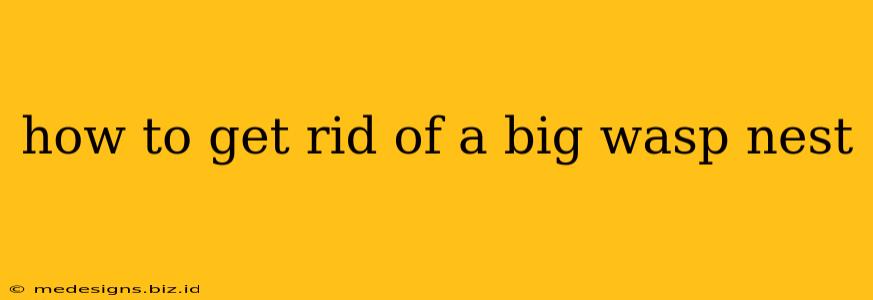Finding a large wasp nest on your property is a serious situation requiring careful and safe removal. Wasps are aggressive when they feel their nest is threatened, so DIY removal can be dangerous. This guide will walk you through the safest and most effective methods, emphasizing professional help when necessary.
Understanding the Risks
Before we delve into removal methods, it's crucial to understand the dangers:
- Wasp stings: Multiple stings can cause severe allergic reactions, even anaphylaxis, which is life-threatening.
- Aggressive behavior: Wasps are fiercely protective of their nests, and disturbing them will provoke a strong, potentially overwhelming response.
- Unforeseen complications: Attempting DIY removal without proper knowledge and equipment can lead to incomplete nest destruction, resulting in a return of the wasps.
Never attempt to remove a wasp nest yourself if you have a known allergy to wasp stings. Seek professional help immediately.
Assessing Your Wasp Nest
Before deciding on a course of action, assess the nest's location and size:
- Location: Is it easily accessible? Is it in a high-traffic area? Is it near power lines or other hazards?
- Size: How large is the nest? A small nest might be manageable with DIY methods (with extreme caution), while a large nest strongly suggests professional intervention.
- Species: Identifying the type of wasp can help determine the best removal strategy. Some species are more aggressive than others.
When to Call a Professional
For large nests, nests in hard-to-reach places, or if you feel uncomfortable, always call a pest control professional. They have the experience, equipment (such as specialized suits and insecticides), and knowledge to safely and effectively remove the nest without putting you or your family at risk.
DIY Removal (For Small Nests Only and with Extreme Caution!)
This method is only recommended for very small nests and should only be attempted if you are comfortable and confident in your ability to handle the situation safely. Even with a small nest, always prioritize safety.
Proceed with extreme caution and consider these points:
- Time of day: Wasps are least active at night or early morning when the temperature is cooler. This is the safest time to attempt removal.
- Protective gear: Wear thick clothing, including long sleeves, long pants, gloves, and a hat. Consider using a beekeeping suit for maximum protection.
- Insect spray: Use a wasp and hornet killer spray designed for outdoor use. Follow the product instructions carefully. Aim for the entrance of the nest, not directly at the wasps themselves.
- Removal: After spraying, carefully knock down the nest, ideally into a garbage bag. Immediately seal the bag tightly.
Prevention
Preventing wasp nests in the future is key:
- Seal cracks and crevices: Wasps often build nests in small openings in walls, roofs, or around windows.
- Remove attractants: Keep food and sugary drinks covered, and promptly clean up spills.
- Regular inspection: Regularly check your property for signs of wasp activity.
Remember: Wasp stings can be dangerous. If you're ever unsure about handling a wasp nest, it's always best to err on the side of caution and call a professional pest control service. Your safety is paramount.
